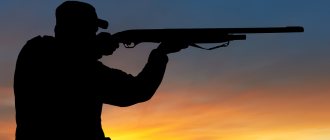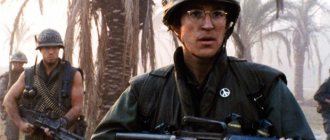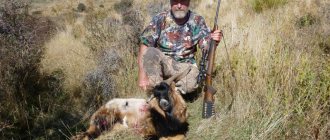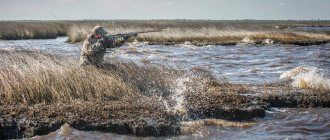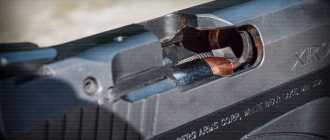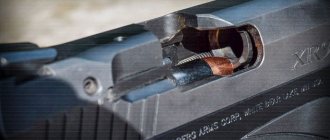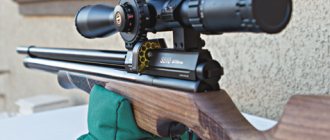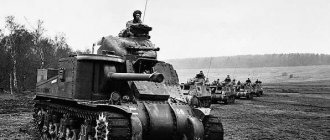- November 3, 2018
- Hunting
- Human
Inexperienced hunters may have some problems when trying to hit the desired game. How to shoot a gun so that there is a good result? The anticipation technique helps with this. Of course, no one will achieve 100% effectiveness, but it is possible to significantly reduce the number of mistakes with it.
Introductory information
What is lead when shooting? This is a technique that involves choosing an aiming point in front of the target, taking into account a certain clearance that is necessary for the ammunition to reach and hit the game. This technique is often called lead shooting. The size of the distance is affected by the speed of the target and the ammunition used. In order to link them, it is recommended to use tables of lead values. At first glance, all this looks very simple. But there are some nuances here. And we will talk about them now.
What do you need to consider?
First of all, it is necessary to note the fact that a novice hunter can rarely clearly identify a suddenly appearing game by eye and compare its size with the numerical value from the table. Therefore, they try to use other meters. For example, the length of the body of a living creature or a gun. Of course, this is not without its drawbacks. But, for example, they recommend that if the distance is fifty meters, then it is necessary to take a lead the length of the barrel. But this approach is not entirely convenient, is not very intuitive, and can cause a number of difficulties. Therefore, the length of large birds is often taken into account. For example, from the beak to the tip of the tail of a black grouse is 65 centimeters, a partridge is 26 cm, a quail is 20 cm. If you use shot No. 7 for a bird flying at a speed of 25 meters per second, then the lead should be 2.73 m. For a quail this is thirteen and a half birds. Mentally, within a second, it is quite difficult to build such a feathered chain. Although if you hunt larger game, for example, take a lead when shooting at ducks in the hulls, then it is a little easier here.
A little about shooting technique
Trying to acquire a moving target requires knowledge and preparation. Correct lead when shooting at ducks, hares and other living creatures is only possible with a proven technique. And here it would be a good idea to consider a couple of useful options:
- Shooting with a stationary option. Involves pointing the gun at a point located along the target line. When the target approaches the calculated distance, you must pull the trigger.
- Shooting with a leash. This is suitable for animals that can change their flight distance and/or their speed. That is, the gun does not stop, but is aimed ahead of the target.
The second option is considered preferable for mass use, since it allows for better performance.
Which approach should I use?
What to do? How to take a lead when shooting if the previously mentioned options are not suitable? It is considered most convenient for beginners to use the muzzle of barrels. This is a convenient and even natural meter. After all, the width of the muzzle can be considered as a tool accompanying the front sight. That is, its value is constant both for the gun itself and for the shooter who uses it. At the same time, the width of the muzzle covers a certain part of the space. Moreover, the further away the target is, the greater the lead. If you look into it, everyone will be able to see that it is not as difficult as it seems at first glance.
Technique example
Let's assume that a gun with horizontally paired twelve-gauge barrels is used. The width of its muzzle is 4.28 centimeters. Whereas from the eyes to the front sight - as much as 90. Shot No. 5 is used to hit a target moving at a speed of 20 meters. For brevity, let's assume that targets will move at right angles to the line of sight. As a result, a pair of trunks will cover approximately 0.96 m. At a speed of 20 m, a lead of 1.32 m is required. Or, in other words, 1.4 times the width of the trunks.
The use of this technique has proven itself very well in hunting. For example, shooting at a flying duck with such a lead at a distance in the range of 20 to 40 meters requires small calculated changes - from 1.4 to 1.6 barrels. The aiming error will be up to 18 centimeters. These values will be more than covered by shot scree. True, if the target moves faster (for example, 25 meters per second), then it would be better to use a lead of two barrel widths. The aiming error is about 27 cm. That is, in the considered options, even bullets can be used relatively successfully (but shot is better). Then shooting at a flying duck with anticipation will be effective.
U = Ut * t,
Where:
- Y is the amount of anticipation;
- Uts — target speed, m/sec;
- t is the time of flight of the shot over the corresponding distance, in seconds.
The formula is used to calculate the lead when using the shooting technique with a moving gun (“with a leash”). In this case, the amount of lead is affected only by the flight time of the shot from the muzzle of the gun to the target and the speed of the target when the shot meets it at an angle of 60-90°. As the angle between the direction of flight of the shot and the direction of movement of the target decreases, the amount of lead also decreases. Table 4, compiled on the basis of the mentioned formula, gives an idea of how shooting technique depends on the approximate amount of lead.
Table 4. Lead value (in m) when shooting at different distances
| Target (animal) and speed of its movement | Leads at a distance | ||
| 20 m | 30 m | 40 m | |
| Fast running fox, roe deer, wolf, elk; a slowly running hare; 8 m/sec | 0,48 | 0,80 | 1,12 |
| Flying snipe, capercaillie; 15 m/sec | 0,90 | 1,50 | 2,10 |
| Sandpiper, hazel grouse, goose flying at medium speed; 20 m/sec | 1,20 | 2,00 | 3,00 |
| Fast flying duck or goose; 25 m/sec | 1,50 | 2,50 | 3,75 |
When the lead shooting technique is used, it should be remembered that with a decrease in the angle of contact of the shot with the target, the offset of the aiming point should be reduced; in case of a crosswind, this point should be moved slightly to the side opposite to the direction of the wind.
It is recommended to hit the wolf in the side immediately behind the shoulder blade, in the neck or head; you should avoid shooting in the forehead or chest of the animal. The most vulnerable places of an elk are between the eye and ear (you can only shoot a bullet at close range), the neck and the area behind the shoulder blades. The boar should also be hit in the side, immediately behind the shoulder blade. The offset of the aiming point when shooting at small birds and animals is shown in Figures 2-5.
Rice. 2. Taking out the aiming point for a “royal” shot at a bird flying over the hunter Fig. 3. Lead when shooting at a bird flying past the hunter Fig. 4. Classic aiming point for a hare moving away from the hunter Fig. 5. Shot at a flying bird
Shooting technique during aiming and shooting largely depends on whether the hunter is standing correctly. The hunter's position, which experienced shooters attach great importance to, should be free and allow him to easily turn his body to the right and left without moving his legs. A comfortable position for the shooter facilitates a well-aimed shot. When using the shooting technique in different directions, the hunter should monitor the position of the feet (Fig. 6).
movement of the barrels from left to right a bird flying overhead a shot at a bird or animal approaching from the left a shot at a bird or animal approaching from the right when turning the body to shoot at a flying bird Fig. 6. The position of the hunter’s feet for different shot directions
The second shot should be fired as quickly as possible after the first, otherwise the shooting technique will deteriorate, so the movement of the gun after the first shot is continued. When distance allows, you can safely target game in open areas. If it flies or runs at the hunter too quickly and unexpectedly, then it is better to let it pass and only then shoot.
A novice hunter can be recommended to use the shooting technique with both eyes open: if you do not close one eye, the shooter’s field of vision will noticeably expand.
The technique of firing a bullet from a shotgun is successful only at a short distance, otherwise the dispersion (the deviation of the bullets from the axis of the barrel and the aiming line) will be so great that it will not be easy to hit the animal. Therefore, when hunting wild boar, elk and bear, the hunter must have great endurance and let the animal come as close to him as possible, then the shot will be accurate and the bullet will retain the required killing power. You rarely have to shoot a bullet and only at large and dangerous animals. Therefore, all bullets with a slight defect - misalignment, potholes or fistulas, uneven wads-shanks, insufficiently spherical shape - should be discarded.
Compliance with these rules will allow the hunter to quickly master the technique of shooting while hunting.
Another example with a mallard and mathematical moments
Let's say we want to get this bird using shot number 5. Its length is 63 centimeters. Flies at a speed of 20 meters per second. If the distance is 25 m, then the lead should be 1.69 m. This is equal to 2.7 mallards or 1.4 pairs of trunks. If the bird is 40 m from the hunter, then the change is not very strong. So, you will have to take a lead of 3.03 m or 5 mallards or only 1.6 trunks.
Do you feel the difference between doubling the production bodies and only 0.2 barrels? And here I would like to make one more digression. Let’s say you need to measure 1.5 pairs of barrels (that’ll be three). It's easy to do. But what to do if you need 1.7 barrels? Measure out tenths? No, it’s enough just to take something like rounded values and estimate approximately. But how to calculate all this? To find out the length of space that is covered at different distances by the width of the muzzle of an existing gun, you need to take a special formula and calculate the value.
Types of hares and their habitat
The white hare got its name due to the change in color from summer gray down to winter white (by winter only the tips of the ears remain gray). It has chosen the forest thickets and shrubs of the tundra and forest-steppe zone of Siberia, Kamchatka, Sakhalin, Western Europe, and is also found in the Chernigov, Saratov, Oryol regions, Mongolia, North America, Hokkaido and Northeast China, in western Greenland.
The weight of an adult varies from 1.5 to 5 kg, body length from 45 to 70 cm. It feeds on the foliage of shrubs and tree bark. The mating season begins in March, during which the females give birth 2-3 times and after half a month the hares are able to take care of and feed themselves.
The hare is much larger than the hare, its ears and tail are longer, and the color on the back and tail remains gray even in winter. Lives in fields, cleared forest edges, steppes, and is rarely found in forests. Lives in Germany, Sweden, England, France, North Africa, Turkey, Crimea, Iran, Transcaucasia, Ukraine. The distribution area of this species begins in the south of the Arkhangelsk region and further in the Caspian steppes, at the mouth of the Ural River, from Siberia to Omsk, gradually spreading towards the Far East. An adult weighs on average from 3 to 6.5 kg, has a body length of up to 70 cm and is capable of speeds of up to 63 km/h. Females breed a litter 3-5 times a year, which contains from 1 to 12 hares.
The hare, called tolai or sandstone, lives in semi-desert and desert areas, mountain and lowland steppes. In addition to Russia, it is found in China, Mongolia, Northeast Africa, Arabia, Iran, and Northeast India. He is much smaller than a hare. Their worst enemies are considered to be wild pigs and birds of prey.
The most rare are the Manchurian hare and wild rabbit. The first has a reddish-gray sometimes completely black color, which does not change by winter, the second is very similar to ordinary hares, but lives mainly in colonies.
Tips for choosing a weapon
Yes, this has a significant impact on shooting technique. And in the most direct way possible. Thus, longer barrels can provide greater accuracy. This will allow you to hit game at long distances. While short barrels provide a high spread of shot. Although if the distance is short, then this will not be needed. The muzzle constriction also has a strong influence. So, if the choke is larger than 0.75 mm, then this is best used by experienced hunters along with specific ammunition. For beginners, knowledge of no more than 0.5 mm is suitable, or better yet, generally 0.25 mm.
Ammo selection
Each target requires a different approach. For example, for a duck, a fraction from 2 to 7 numbers works well. If the hunt is for fragile animals, then you can use 6 or 7. Although if you use such a lead when shooting at a roe deer, then, most likely, you will only get a wounded animal. And an attempt to hit a bear with shot No. 7 will most likely end sadly for the hunter, because this is an animal that is resistant to wounds. If you plan to fire at birds, then the best solution would be to use shot No. 5.
Preparing for the hunt
When going into the forest, you need to decide on the type of equipment, what shot to use for a hare, and prepare a weapon. However, all this does not guarantee that the hunt will be successful. You need to have a good sense of direction in order to find the animal’s fat, understand where you can choose a hiding place and which side is best to enter from.
This is not a problem if the hunt takes place in the same place for many years in a row. But if it’s new, then you need to look for options: hire a guide, ask local hunters. Therefore, everything else should be ready for hunting and not cause headaches.
Modern industry offers many different types of equipment, weapons, ammunition and shot. The main thing is to clearly know what exactly you need.
Useful tips
For a successful hunt, little tricks will come in handy. They will increase the effectiveness of fire:
- Whatever direction you have to move, it should be done using the body, not the arms. This should become an indisputable rule for the shooter.
- If there is no practice, then the best solution would be to go for waterfowl when the hunting season opens. They are both very numerous and easy prey.
- When hunting, you always need to show restraint. This is necessary in order to choose the right moment to shoot. There is no need to rush to shoot at the first bird you see. So, if you notice a duck as part of a flock, you can safely shoot it. And if you wait until it drops, you can count on several birds.
- When hunting big game, it is best to operate at a distance of 20-30 meters. If dogs are used, then the use of buckshot at a distance of less than 10 meters is unacceptable! Only bullets.
- Fire deliberately and accurately. After all, without a good dog, not only a wounded duck, but even a fully formed duck can get lost in the area surrounding the hunter. But unfound game is not only a spoiled mood, but also an innocently lost life.
- It is better to use self-loading shotguns or double-barreled shotguns with ejectors to increase the rate of fire. Also, special attention should be paid to their bed. It should provide comfort in use and maintain good balance.
Decoy for roe deer
Hunting for decoy is an exciting activity. It can be considered in two aspects - a decoy to “roar” during the mating season and luring out, as an additional element of the running hunt. The roe deer rut begins in August. Gurans “bark” to indicate territory and inform females. But the luring process itself consists of simulating the calling cry of the female. Males do not look for each other to fight and fight only for the possession of a specific female if they approach her at the same time. This is a clear difference from roar hunting for other ungulates. In the early morning hours or before sunset, such a roll call begins. It is necessary to use the decoy skillfully. This skill is achieved with certain experience and attentiveness to natural sounds. Gurans love forest clearings, wide clearings, but not fields. Therefore, it is necessary to survey such areas first. All principles of concealment and device on numbers remain in force here. During the rut, young bucks may be less careful when calling for a female, but old, experienced gourans are very sensitive even in these cases. Therefore, it is necessary to listen to the surrounding space. The first calls of the female should be imitated not loudly, so as not to alert the male if he is nearby. After making two or three sounds at short intervals, you should lie low for 15-20 minutes and wait for a response. Perhaps the male will come over to check.
If this does not happen, then you need to reproduce the female’s cry more strongly and hide again. If there is a male in the tract, he will certainly approach the cry of the female, you need to wait at least half an hour. If the hunter chose the right place and did not give himself away either by smell or movement, the guran will inevitably enter the clearing. If something alarms the roe deer, he will bark and leave. In this case, you need to change your position at a distance of at least a kilometer, choose a convenient place and start luring again.
The sound of a baby roe deer on a female has the same effect. After the first week of birth, a roe deer calf can move independently; by autumn it is almost equal in size to its mother, but continues to cling to its parents. The thinner roe call will lure any wild goat, regardless of whose calf it is. In this case, the roe deer respond, which may be an additional factor in determining the location of the family. The fact is that by winter, roe deer gather in such herds. The male organizes his harem, the young of the year stick to their mother. With such communities it is easier to resist attacks and it is easier to find food. The response of a roe deer to the call of a calf will indicate the presence of a herd.
Differences in the principles of firing at various animals
Each animal requires its own approach:
- The lead when shooting at a hare must take into account that these animals can suddenly change their direction, and also move not in a straight line, but in zigzags.
- When hunting big game, it is necessary to take into account that it is better to fire from the side, and not from the front or rear.
- Ducks are easiest to harvest when they fly vertically. To do this, just cover the intended target with the trunks and press the hook. If the duck sits down, then the trunks must be moved down in the direction of its movement.
- Geese are hunted either from hiding, or during the flight from water to fields for feeding. There's no need to rush. You should wait for the optimal moment. If the bird is just flying, then in this case it is necessary to increase the lead, since they fly fast and high.
- Wading birds. It is not recommended to shoot at them in the opposite direction. After all, in this case, the target area to be hit is small. It is also advisable that the fire be opened in an open place, when bushes and tree branches do not interfere. In forests, the distance of the shot is not long, so the birds do not have time to gain speed. In this regard, preemption is practically not used.
- Grouse and pheasant. If they leave vertically, then they can easily be shot offhand. When moving away from a person, they open fire from the approach. Pheasants, by the way, go into horizontal flight one and a half meters from the ground. They freeze at the extreme point of their rise. This is where you need to seize the moment and shoot at the target.
- Wild pigeons are hunted like ducks. But this bird, if frightened by a sudden movement or shot, becomes unpredictable. It is impossible to predict the trajectory of its flight. The best solution is to wait a little and then continue hunting.
Shooting bullets at wild boar, elk, deer and roe deer during driven hunting
When there is a driven or roundup hunt, hunters with rifled weapons stand on the flanks of the shooting line. In most cases, such places are edges, wide clearings or fields. The shooters are faced with the task of preventing the animal from breaking out of the pen through the flanks and leaving. Accordingly, shooting can be carried out at different distances: short, medium, and long.
Sokhaty at different distances
A rifled bullet has enormous speed. Taking this into account, at a distance to the target not exceeding 100 m, there is no need for preemption.
When firing, the front sight of the gun should be aimed at the front part of the animal’s body, at the “meat”. When shooting at a greater distance at animals that can move at high speed, such as deer or roe deer, you need to shoot with anticipation.
Inaccurate aiming is determined by eye; it is enough to see a fountain of snow or earth raised by a bullet. The next shot is made with the appropriate adjustment. When hunting is carried out in open space, a regular whistle is sometimes used.
A racing animal, hearing the whistle, stops abruptly, at which point a targeted shot should follow.
The rifle chain itself is located along the road or a small clearing in the forest. The chain consists mainly of hunters with smooth-bore weapons. According to the rules, shooting is carried out at a distance not exceeding 45 m. The hunter, having stood in the place prescribed to him, “on the number”, must first mark the expected firing zones. Such zones can be clearings, small “visirs”, paths made by animals, in other words, any gaps between trees. Tree branches or bushes interfere with shooting, since the bullet, even with minimal contact with them, will leave the correct trajectory.
Wild boar, deer, and elk are large animals, so usually the hunter notices them in advance or even hears them approaching. As soon as the shooter hears or sees an animal, it is best to immediately raise the gun. If you do this when the animal immediately appears in the shooting zone, you can scare it away by accidentally catching the butt on your clothing.
The animal must be brought as close as possible to confidently hit the target, choose a convenient opening from those that were predetermined, and shoot without preemption at the “kill” place on the animal’s body.
Moose sighting spots
Using a leash when hunting in the forest is undesirable due to the large number of obstacles in the form of trees, bushes, etc. When shooting with a leash, the weapon continues to move after sighting, that is, the risk of hitting an obstacle on the trajectory of an elk or wild boar is very high. Therefore, it is recommended not to “lead” the animal from the moment of its appearance, but to calmly wait until it appears in the place planned for the shot. If the animal suddenly changes direction, the hunter has enough time to move the weapon in the right direction.
The beast came at the shooter
The places for a successful shot on the body of a large animal are the head, neck, spinal cord and heart.
Experienced hunters advise simply shooting at the widest front part of the body of an elk, wild boar or deer. As a result of such a shot, even a very large animal will not go far, but most likely will fall immediately. If a bullet hits the intestines, the wounded animals move away to a distance of a kilometer or more. In hunting slang, such animals are called “trackers.” Attempts to aim at the head or neck are often unsuccessful, even if the animal is standing still. In cases where the hunter has a relatively large amount of time to accurately aim, it is recommended to aim slightly behind the animal’s shoulder blade. In this way the lungs are affected, that is, the shot will be effective. You can also aim at the neck of a boar, since it is significantly wider than that of an elk or deer. A bullet in the neck will result in a fatal injury.
Boar slaughter places
It is common for a hunter to intuitively point the front sight at the front of the animal’s body. This part of the animal’s body is precisely the most “lethal” one.
According to statistics, almost all ungulates that receive a shot in the body in the shoulder blade area become prey for the hunter. Hitting the heart or sacrum will also prevent the animal from escaping, but aiming for the sacrum makes no sense, since hitting this point is more likely to happen by accident.
When a deer or elk is running straight at a hunter, shooting the animal will be most effective when aimed at the chest. The wild boar, unlike elk and deer, is shorter than human height, so the hunter can aim at the middle of the animal’s forehead. If the distance to the target is small, both a smooth and, even more so, a rifled bullet can pierce the skull bone of a wild boar, no matter how large it is.
Frontal aiming
